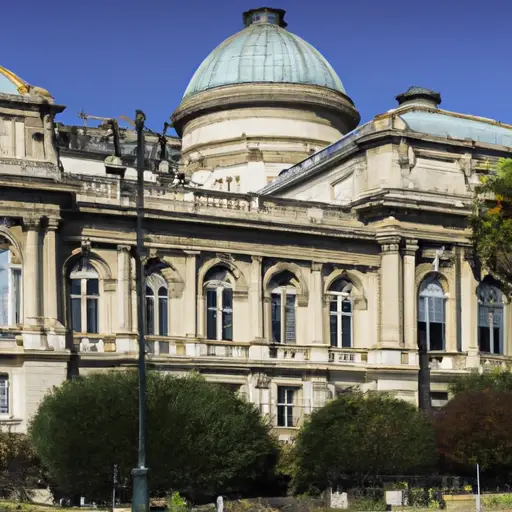Museo Nacional de Historia Natural, Buenos Aires : Interesting Facts, Information & Travel Guide

- By
- Aparna Patel
- |
- 21 Jun, 2023
- |

Welcome to the Museo Nacional de Historia Natural, Buenos Aires: an exciting destination for all nature and history lovers. Located in the vibrant city of Buenos Aires, Argentina, this museum offers a unique look into the nation’s natural history. From ancient artifacts and fossil remains, to exhibits of current conservation efforts, the Museo Nacional de Historia Natural is an intriguing place to explore. This guide will provide interesting facts and enlightening history about the museum, as well as helpful information for those planning a trip to see it in person. Here, you can discover the beauty and majesty of the natural world in one of the world’s most stunning cities.
Table of Contents
Interesting Facts About Museo Nacional de Historia Natural, Buenos Aires
1. The museum’s permanent collection features over one million specimens from plants, animals, and fossils collected from all around the world.
2. One of the museum’s main attractions is the Antarctic Hall, which has a series of marine fossils along with specimens collected from the expedition of the Argentine Marine National Parks.
3. The Universidad Austral opened the world’s largest meteorite collection in the museum with 1,500 pieces, many of which date back to the early 20th century.
4. The museum houses a private collection of pre-Columbian pottery and art from South America.
5. Several interactive exhibits are available for visitors to explore in the museum, including a Virtual Reality experience.
6. The Science Park is a popular area of the museum and offers hands-on science and technology experiments for visitors.
7. The museum has a number of research laboratories dedicated to the study of botany, zoology, ornithology, paleontology, and astrophysics.
8. The Museum is home to a range of educational programs, including workshops, seminars and lectures open to the public.
History & Information About Museo Nacional de Historia Natural, Buenos Aires
Museo Nacional de Historia Natural (MNHL) is the Argentine national museum of natural history, located in the Palermo neighborhood of Buenos Aires. Founded in 1887, it is one of the oldest natural history museums in South America and houses a large collection of rare specimens from around the world. The museum is known for its research and education programs, and is home to the Carlos Thay Natural History Library. The museum’s collection contains over 1 million specimens, including mammals, birds, amphibians, reptiles, mollusks, insects, and fossils, among others. Visitors can view various temporary and permanent exhibitions, such as the Hall of Ornithology, the Dino-Mammal Hall, the Hall of Reptiles and Amphibians, and the Fishes and Invertebrates Hall. The museum also has numerous interactive displays, activities, and conservation projects for students, researchers, and the public.
- Museo Nacional de Bellas Artes de Neuquén, Neuquén : Interesting Facts, Information & Travel Guide
- Casa Natal de Sarmiento, San Juan : Interesting Facts, Information & Travel Guide
- Monumento a la Bandera, Rosario : Interesting Facts, Information & Travel Guide
Travel Guide For Visiting Museo Nacional de Historia Natural, Buenos Aires
1. Getting to the Museum: The Museo Nacional de Historia Natural is located in Parque Tres de Febrero in Palermo, Buenos Aires. It is a short distance from the Aeroparque Jorge Newbury airport, the Haedo suburban train station, the Lacroze bus station, and the city center. The best way to get to the Museum is by public transportation, as parking may be difficult to find.
2. Hours of Operation: The Museum is open Monday-Friday from 10:00 am to 6:00 pm, and on Saturday and Sunday from 10:00 am to 1:00 pm.
3. Admission: Admission to the Museum is free for all visitors.
4. What to Expect: The Museum covers the natural history of Argentina, from ancient rock formations to modern-day climate change. This includes displays of dinosaurs, fish fossils, insects, reptiles, flora, and even a few filmic specimens of extinct animals. It also has a section dedicated to current day environmental issues and potential solutions.
5. Additional Information: Guided tours are available upon request (reservation required). The Museum offers educational programs, special exhibits, and lectures throughout the year. The Museum also has a café and an auditorium for events.
- Iguazu Falls, Misiones : Interesting Facts, Information & Travel Guide
- Los Glaciares National Park, Santa Cruz : Interesting Facts, Information & Travel Guide
- La Manzana de las Luces, Buenos Aires : Interesting Facts, Information & Travel Guide
Frequently Asked Questions About Museo Nacional de Historia Natural, Buenos Aires
Q: What features does the Museo Nacional de Historia Natural in Buenos Aires have?
A: The Museo Nacional de Historia Natural in Buenos Aires features a variety of exhibitions related to the history of nature, life sciences, and technology. The exhibitions range from short-term exhibitions to long-term installations, permanent exhibitions, and showcases dedicated to specific topics. Additional features of the museum include educational activities and programs, guided tours, and a library of related materials.
Q: Does the Museo Nacional de Historia Natural in Buenos Aires have any special events or activities?
A: Yes, the Museo Nacional de Historia Natural in Buenos Aires regularly hosts a variety of events, such as lectures, educational activities, and workshops, as well as musical performances and guided tours. Additionally, the museum is home to the Wild Planet Festival, a three-day celebration of biodiversity, held each December.
Q: What are the visiting hours for the Museo Nacional de Historia Natural in Buenos Aires?
A: The Museo Nacional de Historia Natural is open Tuesday through Sunday, from 11:00 am to 6:00 pm. On holidays, the museum closes at 5:00 pm.
Search Posts
Latest posts
-
4 Mar, 2024
How to make dining alone less awkward?
-
5 Mar, 2024
How to avoid drinking vodka?
Popular posts
-
5 Mar, 2024
Why prohibit engine braking?
-
5 Mar, 2024
How to avoid drinking vodka?